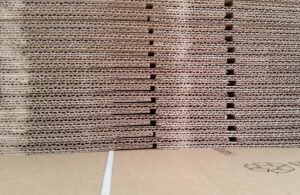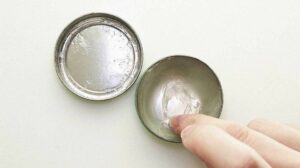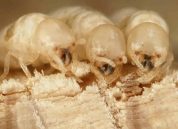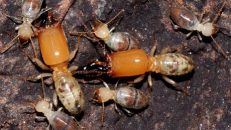So you’ve realized you have a termite problem and now you’re looking for the solution? Luckily you’ve come to the right place and our guide will teach you the most effective ways to remove termites from your home both naturally and through some less natural methods.
Contents
Best natural methods to remove termites
There are many methods that you’re likely to already have the necessary components for around your home and these are often very effective at preventing and removing termite problems.
The Cardboard Trap

Damp cardboard is an effective trap
This is one of the most common and natural methods thanks to it being so simple to do, it’s likely that you’ve already got the items to you need to get going.
All you need is a piece of cardboard, preferably corrugated, to act as bait for the termites as this is high in cellulose – a termites main food source.
Simply lightly dampen the cardboard by spraying it with water and then leave it close to the area that you think is infested with termites.
Termites should then begin to feed off it and group themselves around it.
Once you notice them pooling on top of the cardboard, pick it up and take it outside to be disposed of.
Whilst this is a popular method and considered humane, the next part is quite brutal.
For this to be an effective treatment you will need to burn the cardboard with the termites on it a good distance away from any buildings.
Unfortunately, this method is only effective against smaller colonies as the larger ones tend to reproduce faster than they will be grouping on the cardboard unless you lay down multiple traps.
Sunlight
This method is only effective for furniture you are easily able to take outside or garden infestations.
Make sure the area of infestation is in an area with a lot of sunlight, if it’s your garden itself that is playing host to the problem then ensure all vegetation in the area is removed so that the sunlight penetrates deeper into the colony.
Infested furniture is treated well with this method, leave the object out in the sunlight for 3 to 5 days and this will dry out the furniture whilst making it too hot and uninhabitable for the colony, causing them to die off.
Temperature controlling treatments
Termites require the conditions to be perfect so this is a method that many pest control companies use.
Obviously, heat and homes don’t usually mix too well but this is the quickest method to kill a termite colony, so ensure that all potentially flammable objects are first removed.

Termites can be killed within 35 minutes if there is an air flow of around 120 degrees Fahrenheit which is around 50 degrees Celsius.
The main downside to this method of treatment is the risk of damage to materials within your home as wood is prone to warping when there is a rapid change in temperature.
On the opposite side of the treatment is the cool air method, this isn’t quite as effective as it requires a much longer period of time to be successful.
This method needs to be carried through up to five days before the colony will be completely eliminated and the temperature needs to be around 15 degree Fahrenheit which is approximately -10 degrees Celcius.
Salt / Salt Water
Salt (sodium chloride) is a very simple, natural solution to a termite problem.
Termites are naturally attracted to salt even though it has dire consequences for them so it makes it an incredibly effective method of both preventing and removing termite colonies.
Mix salt into water until it’s saturated then you apply it to the areas you think are infested with termites in a method of your choice.
The easiest method that provides the deepest penetration would be using a spray bottle and applying the solution directly into the entrances of the nests.
Other alternatives include cotton wool balls, soaked paper towels, piles of salt near the entrances.
Parasitic Nematodes
These are a natural predator to termites but can only be used outside, this is the best way for simply assisting nature in taking its natural course.
You simply need to introduce them to the earth in close proximity of the nests and then give them time to begin feeding on the colony and keeping control of its numbers.
Obviously the more you introduce, the quicker the colony will be destroyed.
You can find these in most of your local department stores or search online for pesticide stores.
Alternative Methods for Termite Removal
Sometimes the natural methods aren’t the quickest or most effective so we have compiled a list of the less natural methods that are very effective in abolishing your termite problem.
We’ve identified a few different chemicals that can be used against the colonies.
What chemicals kill termites?
There’s a variety of active chemicals that kill termites, there’s even some in commonly found products in the home that can be used.
 Petroleum Jelly
Petroleum Jelly
You’re likely to already have this lying around your home, it’s a great way for preventing an infestation in the first regard as it contains an ingredient called phenol and this repels termites.
Apply this around your windows and doors for a short term preventative measure.
Boric Acid
You might know this in the home as Borax, but its scientific name is boric acid.
This acid is very effective at killing termites, the acid is a neurotoxin to them and shuts down their central nervous system then dries them out so they die quickly.
Amply apply the acid to all areas where you have identified an infestation but make sure that any pets or children do not come into contact with these areas as you do not want them to start licking it.
Borax can also be used as a preventative measure by mixing it with water and using a sprayer to coat your doors/windows/walls every other day and this will decrease the likelihood of termites settling.
Fipronil
Fipronil is found in a wide variety of insecticides and can be identified as being present by checking the active ingredients list on your product.
It works by disrupting the central nervous system of insects and is much more toxic to pests than humans but you still must use the utmost care when being in close proximity to it.
Fipronil can kill termites instantly in high concentrations, this is what makes it one of the more popular methods.






